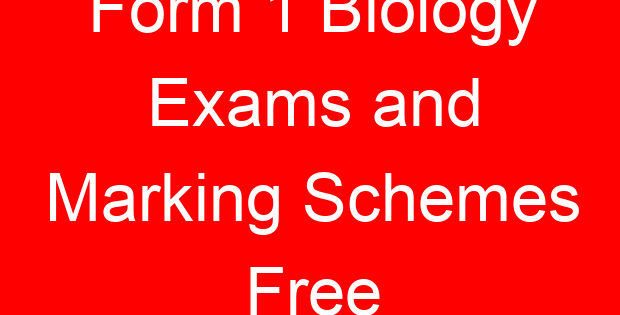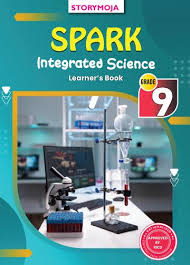Form 1 Biology Exams and Marking Schemes Free
Form 1 Biology Exams and Marking Schemes Free
NAME ………………………………………………..CLASS …………ADM NO.………………
SIGNATURE …….…….……..………………….. DATE……………………..
BIOLOGY
FORM ONE
2 hours
JOINT EXAMINATIONS-2023
Instructions to candidates
- Write your name, class and admission number in the spaces provided above.
- Sign and write the date of examination in the spaces provided above.
- Answer ALL the questions in the spaces provided.
This paper consists of 7printed pages.Candidates should check the question paper to ascertain that
all the pages are printed as indicated and no questions are missing
1.
- i) State one process that takes place during the light stage and one that takes place in the dark stage of photosynthesis. (2mks)
Light stage;…………………………………………………………………………………………
Dark stage;…………………………………………………………………………………………
- ii) Name three products of the light stage of photosynthesis (3mks)
………………………………………………………………………………………………………………………………………………………………………………………………………………………………………………………………………………………………………………………………………………………………………………………………………….……………………
- c) Name two types of cells in the leaves where photosynthesis occurs (2mks)
………………………………………………………………………………………………………………………………………………………………………………………………………………………………………………………………………………………………………………………………………………………………………………………………………………………………
- Name one example of the specialized cells in plants and one example in animals.
(i)Plants (1mk)
……………………………………………………………………………………………………….
(ii) Animals (1mk)
……………………………………………………………………………………………………….
- Identify the following apparatus and state its functions.
- i) Name……………………………………………………(1mk)
- ii) Function (1mk)
……………………………………………………………………………………………….……………………………………………………
- A student measured the length of a mitochondrion on a photomicrograph whose magnification was X 40000 and found it to be 1mm. Calculate the actual size of the mitochondrion in micrometres. (3mks)
- State the type of solution that makes the plant cell. (2mks)
- i) Flaccid……………………………………………….………………………………………………
- ii) Turgid………………………………………………………………………………………………
- Name the carbohydrate stored in:
- i) Cell wall…………………………………………………………………………………….(1mk)
- ii) Mammalian liver.…………………………………………………………………………. (1mk)
- Name the monosaccharides that make up the disaccharides below
- a) Sucrose………………………………………………………………………………………(1mk)
- b) Lactose……………………………………………………………………………………… (1mk)
- c) Maltose………………………………………………………………………………………(1mk)
- (a) Name three characteristics of living organisms (3mks)
………………………………………………………………………………………………………………………………………………………………………………………………………………………………………………………………………………………………………………………………………………………………………………………………………………………………………………………………
(b) Apart from Plantae and Animalia, name three other kingdoms. (3mks)
………………………………………………………………………………………………………………………………………………………………………………………………………………………………………………………………………………………………………………………………………………………………………………………………………………………………………………………………
- Draw a well labeled diagram show the external parts of a simple leaf (6mks)
- Give two characteristics that distinguish scientific names from common names. (2mks)
………………………………………………………………………………………………………………………………………………………………………………………………………………………………………………………………………………………………………………………………………………………………………………………………………………………………………………………………………………………………………………………………………………………………………………
- (a) What is cell specialization (2mk)
………………………………………………………………………………………………………………………………………………………………………………………………………………………………………………………………………………………………………………………………………………
(b) Name three types of tissues found in animals (3mks)
………………………………………………………………………………………………………………………………………………………………………………………………………………………………………………………………………………………………………………………………………………………………………………………………………………………………………………………………
(c) Name twomain types of lenses found on a light microscope (2mks)
………………………………………………………………………………………………………………………………………………………………………………………………………………………………………………………………………………………………………………………………………………………………………………………………………………………………………………………………
- The diagram below represents the digestive system in man. Study the diagram and answer the
questions that follow
| P |
| S |
(a) Label the part K ,L, and salivary glands M and P (4rnks)
K …………………………………………………………………………………………………………
L………………………………………………………………………………………………………….
M…………………………………………………………………………………………………………
P………………………………………………………………………………………………………….
(b) Name three hormones which are secreted along the alimentary canal (3mks)
………………………………………………………………………………………………………………………………………………………………………………………………………………………………………………………………………………………………………………………………………………
- List down four differences between a light microscope and an electron microscope (4mks)
| Light Microscope | Electron Microscope |
- List down four factors that determines energy requirements in human being: (4mks)
………………………………………………………………………………………………………………………………………………………………………………………………………………………………………………………………………………………………………………………………………………………………………………………………………………………………………………………………
- Define the following branches of Biology.
(2mks)
- i) Genetics
……………………………………………………………………………………………………………………………………………………………………………………………………………..……………………………………………………………………
- ii) Entomology
……………………………………………………………………………………………………………………………………………………………………………………………………………………………………………………………………………………
- State the functions of each of the following organelles.
- Nucleolus (1mk)
…………………………………………………………..………………………………………………
…………………………………………………………..………………………………………………
- Golgi apparatus (2mks)
……………………………………………………………………………………………………………………………………………………………………..…………………………………………………………..………………………………………………….…………………………………………………………..………………………………………………………………………………………………………………………………………………………
- The diagram below represents a longitudinal section of a human tooth.
| S |
- Identify the type of tooth. (1mk)
…………………………………………………………………………………………………………………………………………………….
(b) Give one reason for your answer in (a) above. (1mk)
…………………………………………………………………………………………………………………………………………………….
(c) State one function of the tooth. (1mk)
……………….…………………………………………………………..………………………………………
(d) State the function of the part labeled Q (1mk)
……………………………………………………………………………………………………………………………………………………………………..…………………………………………………………..………………………………………
- e) Name the parts labeled P, Q, R, and S (3mks)
P…………………………………………………………………………………………………………………………………………………..
Q………………………………………………………………………………………………………………………………………………….
R………………………………………………………………………………………………………………………………………………….
S…………………………………………………………………………………………………………………………………………………..
- An experiment was set-up in a laboratory as shown below.
- What will happen to visking tubing in M and N after two hours. (2mks)
M…………………………………………………………………………………………………………………………………………………………………………………………….
N…………………………………………………………………………………………………………………………………………………………………………………………….
- Explain the observations made in M. (2mks)
……………………………………………………………………………………………………………………………………………………………………………………………….
- What does visking tubing represent in a living organism? (1mk)
………………………………………………………………………………………………
- The diagram below represents the lower jaw of a mammal.
- Name the mode of nutrition of the animal whose jaw is shown above. (1mk)
………………………………………………………………………………………………………
- Mode of feeding. (1mk)
………………………………………………………………………………………………………
- Give a reason for your answer in (b) above. (1mk)
………………………………………………………………………………………………………
- Diet of the animal. (1mk)
………………………………………………………………………………………………………
- Name the toothless gap labeled K. (1mk)
………………………………………………………………………………………………………
- Name the substance that is responsible for hardening of teeth. (1mk)
………………………………………………………………………………………………………
________________________________________________________________________________________________
MARKING SCHEME BIO FORM ONE
1.i) Light stage : Photolysis (1mk)
Dark stage: Carbon (IV) Oxide fixation (1mk)
- ii) – Hydrogen ions
– Adenosine triphosphate /energy rej; ATP
– Oxygen
- c) guard cells, palisade cells,spongy mesophyll cells
- In plants- Guard cells; root hair cells; palisade cells
In animals- sperm cell; white blood cells; Red blood cells; nerve cells.
- (i) pair of forceps’;
(ii) picking up small stinging crawling animals;
- Mag. = image size ; 1mm = 1000 m
Actual size
= 1mm x 100
Actual size
Actual size = 1000 m ; = = 0.025
40,000
- (i) Hypertonic solution; acc. Highly concentrated solution (1mk)
(ii) Hypotonic solution; acc. More dilute solution;
- – (i) Cellulose; (ii) Glycogen;
- Glucose and fructose;
Glucose and galactose;
Glucose and glucose;
8 (a) Nutrition; Growth and development;
Respiration; Reproduction;
Gaseous exchange; Irritability;
Excretion; Movement;
| Apex |
| Margin |
| vein |
| Petiole/leaf stalk |
| Leaf blade/ lamina |
| Midrib |
- Monera;Protoctista/protista;Fungi;
9.
Mark any four correct parts(4mks)
Drawing 2mks
- ( Two names used) -first name – generic, second name species;
-Two names italicized /underlined separately /
-First names capital, second; name small letter;
- (a) Structuraldifferentiation / modification of cells to perform specific function;
(b) Epithelial tissue;
Skeletal;
Blood;
Connective tissue; Mark the 1st 3
- c) – Objective lenses
– Eye piece lens
-Condenser lens
12.a) K – Liver
L -Oesophagus/gullet
M -Sublingual salivary glands
P -parotid salivary gland
- b) – gastrin
– Secretin
– Cholecystokinin
| Light Microscope | Electron Microscope |
| Low magnification power | High magnification power |
| Low resolving/resolution power | High resolving/resolution power |
| Uses light rays to illuminate specimens | Uses a beam of electrons to illuminate specimens |
| Can be used to view both live and dead specimen | Used to view only dead specimen |
14.- Basal Metabolic Rate(BMR) – sex
– Age – occupation/everyday activity
– SurfaceArea to volume ratio/ body size- lactation & pregnancy
- Define the following branches of Biology. (2 marks)
- i) Genetics-Study of inheritance and variation
- ii) Entomology-Study of insects
- a) Production of ribosomes.
- Packaging and transport of glycoprotein’s
Secretion of synthesized proteins and carbohydrates.
Production of lysosomes.
- (a) Molar; accept pre-molar.
(b) Presence of two roots; presence of cusps; accept any one.
(c) chewing/crushing/grinding food;
(d) Detect stimuli;(pain,heat,cold)
(e). P enamel
Onerve fibre
R blood capillaries
S pulp cavity
18.An experiment was set-up in a laboratory as shown below.
- What will happen to visking tubing in M and N after two hours. (2mks)
M – will swell / increase in size
N – Will shrink / decrease in size
- Explain the observations made in M. (2mks)
Sodium chloride solution is a hypertonic solution while distilled water is a hypotonic solution therefore distilled water molecules will move from the beaker to the visking tubing by osmosis making it to swell.
- What does visking tubing represent in a living organism?Semi permeable membrane
19.a) Name the mode of nutrition of the animal whose jaw is shown above. (1mk)
Heterotrophism
b.Mode of feeding. (1mk)
Herbivorous /herbivory
c.Give a reason for your answer in (b) above. (1mk)
Presence of a diastema
- Diet of the animal. (1mk)
Vegetation/ grass/green leaves.
- Name the toothless gap labeled K. (1mk)
Diastema
- Name the substance that is responsible for hardening of teeth. (1mk)
Calcium phosphate&carbonates




